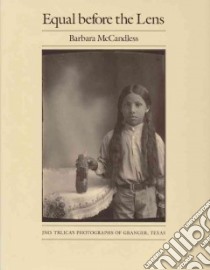Equal Before the Lens - 9780890964866
Un libro in lingua di Barbara McCandless edito da Texas A & M Univ Pr, 1992
- € 26.80
- Il prezzo è variabile in funzione del cambio della valuta d’origine
People have always documented the turning points in their lives: births, christenings, first communions, graduations, weddings, deaths. For much of the twentieth century, this documentation frequently included a trip to the local professional photographer for a formal portrait. Barbara McCandless records here the events in the lives of the residents of Granger, Texas, through the work of Jno. P. Trlica, the community’s sole full-time photographer from 1924 to 1955.
Granger, a small rural community in the rich blacklands of the state’s central region, is both typical of small Texas towns and unique in its specific story. The transition from a railroad-based to an automobile-based economy and the problems experienced by agricultural communities relying upon the sole crop of King Cotton” are two chapters told poignantly in the story of Granger. In addition, all the major cultural groups of TexasSouthern Anglos, blacks, Hispanics, and European-immigrant communitiesexisted in close proximity in the town and experienced all the intercultural tensions that peaked in the 1920s.
Jno. P. Trlica was a first-generation Czech Texan; as part of a marginal subgroup himself, he had access to all the subgroups of Granger. Trlica was especially devoted to his own Czech culture and intentionally documented its groups and social events, as well as the business and social activities of the town of Granger, but his portrait business was open to all segments of society. While other businesses in Granger refused to serve blacks and Hispanics, the Jno. P. Trlica Studio may have been one of the few places in the town where all cultures crossed paths. His portraits today serve as a social history not just of the privileged classes, but of all the people of Granger and the surrounding countryside. They also serve as a testament to a time in photography’s past when the posed studio portrait was both an art form and a significant part of life in small-town America.
Granger, a small rural community in the rich blacklands of the state’s central region, is both typical of small Texas towns and unique in its specific story. The transition from a railroad-based to an automobile-based economy and the problems experienced by agricultural communities relying upon the sole crop of King Cotton” are two chapters told poignantly in the story of Granger. In addition, all the major cultural groups of TexasSouthern Anglos, blacks, Hispanics, and European-immigrant communitiesexisted in close proximity in the town and experienced all the intercultural tensions that peaked in the 1920s.
Jno. P. Trlica was a first-generation Czech Texan; as part of a marginal subgroup himself, he had access to all the subgroups of Granger. Trlica was especially devoted to his own Czech culture and intentionally documented its groups and social events, as well as the business and social activities of the town of Granger, but his portrait business was open to all segments of society. While other businesses in Granger refused to serve blacks and Hispanics, the Jno. P. Trlica Studio may have been one of the few places in the town where all cultures crossed paths. His portraits today serve as a social history not just of the privileged classes, but of all the people of Granger and the surrounding countryside. They also serve as a testament to a time in photography’s past when the posed studio portrait was both an art form and a significant part of life in small-town America.
Informazioni bibliografiche
- Titolo del Libro in lingua: Equal Before the Lens
- Sottotitolo: Jno. Trlica's Photographs of Granger, Texas
- Lingua: English
- Autore: Barbara McCandless
- Editore: Texas A & M Univ Pr
- Collana: Texas A & M Univ Pr (Hardcover)
- Data di Pubblicazione: 01 Luglio '92
- Genere: PHOTOGRAPHY
- Argomenti : Photograph collections Texas College Station
- Dimensioni mm: 292 x 234 x 25
- EAN-13: 9780890964866


